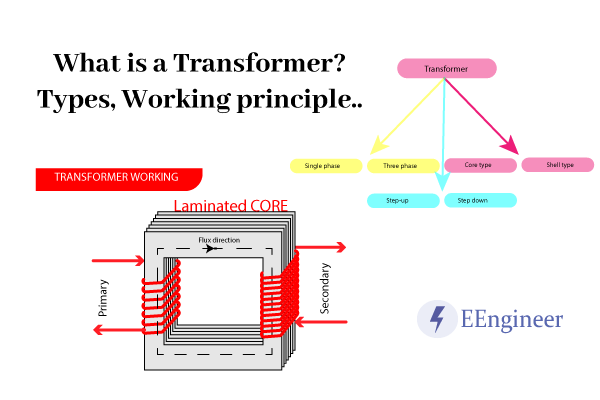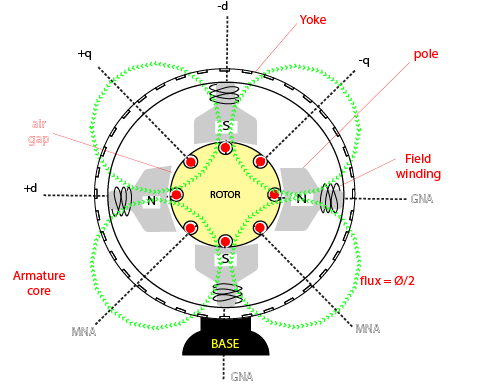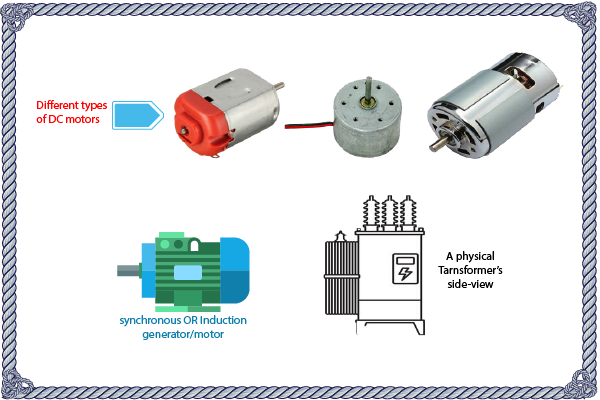Continuous Electro-mechanical energy conversion devices are known as Electrical machines. Which is a reversible process.
Table of Contents
Electrical machines are machines that are either used to transfer or the generation of Electrical power. These may be low-power or high-power devices(in mV or kV). Here I am discussing the high-power devices in this article.
Types of Electrical Machines:
- Transformer (not an electrical machine, it is a static device).
- DC Machine (generator and motor).
- Induction Machine (generator and motor).
- Synchronous machine (generator and motor).
Basic things to know before jumping into electrical machines for better understanding!!!
Much useful if you are an engineering student
Things to know:
From Electrical NETWORKS
- Ohm’s law.
- KVL and KCL (‘kirchhoff’s voltage law’ and kirchhoff’s current law).
- Basic network analogy (mesh Theorem, nodal theorem, Thevenin’s Theorem, MPPT, Millman’s theorem).
- Ideal voltage and current.
- what is an open/ short circuit?
- what is source or sink?
- star-delta Equivalence.
- sinusoidal and steady-state Response in AC (Alternating Current).
- RLC circuit.
- Phasor diagrams. (very important).
- Instantaneous power, Active power, reactive power, and complex power.
- Balanced 3-Phase AC system {DELTA and STAR connection}.
From Magnetism
- Ampere Circuital Law.
- Series, parallel magnetic circuits.
- Faraday’s 1st and 2nd law.
- Lenz’s law (mainly for the direction of the current I).
- Flemming’s “Left-hand rule” and “Right-hand rule”.
1} Transformer

The transformer is not an electrical machine, it is a static device, it only changes the voltage level from one level to another level. In this Energy conversion/ transfer is due to the mutual flux.
Flux: Time-varying (stationary).
Conductor: Stationary.
Hence, here is only statically induced EMF (Electro-Motive Force). Because it has primary winding and secondary windings physically connected by the core). Which is non-movable.
2} DC electrical machine (generator and motor)

DC machine is the common name given for the DC Generator and DC motor.
It works on the principle of Faraday’s Law of EMI (Electro-Magnetic Induction).
DC Generator :
Rotating electrical machine which is designed to take the advantage of Electro-magnetic induction in order to convert mechanical energy into DC electrical energy.
- converting “mechanical Energy” to “Electrical Energy”.
- Voltage is produced {Simultaneously torque is also produced in order to oppose the applied torque}.
DC motor :
Rotating electrical machine which is designed to take the advantage of Electro-magnetic induction in order to convert DC electrical energy into mechanical energy.
- Converting “Electrical Energy” to “mechanical Energy”.
- Mechanical torque is produced {Simultaneously opposite EMF (back EMF) is also produced to oppose the applied EMF.
Hence DC machine can be used as a Generator as well as a Motor.
Flux: Time-Invarying (stationary).
Conductor: Rotating
Hence, Dynamically induced EMF
DC Generator = AC Generator + commutator (Split Rings)
Applications :
- DC Generator is not used in vast applications (because for heavy power usage its size increases)
- DC Motors are widely used in electronics with low power.
- Toys
- trimmers
- mobile vibrations
- drones etc
3} Induction electrical machine (generator and motor)
Due to complex construction, commutation problems, and maintenance. DC machines find fewer practical applications.
While AC motors have a simpler construction and less maintenance. Hence, these are the most popular (85% motors).
These work on the principle of RMF (Rotating Magnetic Field).
Flux: Time-varying (stationary).
Conductor: Stationary.
It is nothing but a rotating transformer. Because its windings are not physically connected by the core.
Applications:
- Ceiling fans
- AC Table fans
- Drill machines
- Washing machines
4} Synchronous electrical machine (generator and motor)
Flux: Time-Invarying (rotating).
Conductor: stationary
Hence, dynamically induced EMF.
Applications:
- Hydropower plants
- Wind power plants
- Also for maintaining reactive power in the power system
